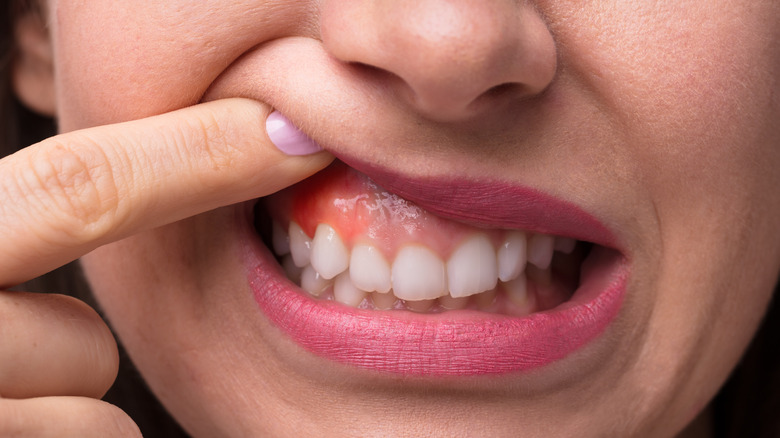It’s no secret that your oral health is tied to your general wellbeing. You may take great pride in the pearly whites that give you a surge of confidence every time you smile wide for the cameras. If you aren’t paying attention to your gums, though, you might be missing out on key indicators affecting your health. Changes to the color of your gums in particular could be indicative of an underlying issue elsewhere in your body. This is why it’s so important to be attuned to the appearance of your healthy gums, as you can more swiftly take action if you suspect that they look different than usual and need some attention.
So what exactly do “normal” gums look like? Generally, healthy gums have a pink tone and feel firm. Note that pink isn’t a uniform color by any means; some people may have darker pink gums, while others’ gums might be a lighter variation of the color. It’s largely dependent on your ethnicity or your race.
Once you know exactly what your gums look like at their best, you’ll have a baseline to compare to if there’s a health concern that causes them to change color. Common discolorations include red, gray, white, and black. Each may be suggestive of a particular health problem — or none at all. When in doubt, always see your dental care provider for a thorough examination. At the very least, your dentist may detect changes that you miss at home.
It could be a sign of diabetes

Diabetes is a condition that causes blood sugar levels to rise. That’s because diabetics’ bodies don’t produce enough insulin, the hormone responsible for converting sugar to energy. Without it, glucose levels can quickly grow out of control and cause a host of symptoms. Issues like general fatigue, weight loss, wounds that are slow to heal, and skin infections are all common. What people may not realize is that diabetes can even cause reddening of the gums.
Because sugar levels in the bloodstream are uncontrolled, it causes an increase in the amount of sugar in the saliva and the gums. This fosters a welcome environment for unhealthy plaque to develop and thrive, which in turn causes gum irritation and issues like redness, cavities, and gum disease. The wounds that take so long to heal can even affect the inside of the mouth, and oral skin infections can develop, too.
As gum disease worsens, the gums may take on an even deeper red appearance. You might notice that they bleed when you brush your teeth, too. As the most common oral health concern diabetics face, the disease can quickly take hold of your gums without proper care. This is why it’s crucial to make proper oral hygiene a priority, including brushing for two minutes at a time at least twice a day and flossing once a day, plus scheduling regular appointments with your dentist. Watching your sugar intake can also help protect your mouth.
Your pale gums may mean you’re anemic

Anemia affects some three million people throughout the United States. It can develop for a number of reasons, but the most common by far is iron deficiency. Other common causes include vitamin A and B12 deficiencies, as well as a lack of folate. People with infections or chronic diseases are also at significant risk of developing anemia. If you’re anemic, you are likely to feel tired often, and you may sleep for hours at a time. Anemia can also cause symptoms like dizziness, pale skin, shortness of breath, headache, and even pale gums.
Dr. Ari Moskowitz, D.M.D., a periodontist, explains to Self that very pale gums in particular could be suggestive of anemia. That’s in comparison to gums that are normally light in tone. If your gums were once pink but now have pallor, it’s a good idea to see your doctor, particularly if you’re experiencing other hallmark symptoms of the disease. A small percentage of patients with anemia may also develop a condition called glossitis, which presents as inflammation, swelling, and reddening of the tongue.
See your doctor if you suspect that you’re anemic, and pay a special visit to your dentist’s office so they can assess the condition of your gums and confirm that you aren’t dealing with decay or another dental health concern. That’s not just to diagnose anemia, but also to confirm that the pale gums aren’t concealing the presence of red gums due to disease.
Hormonal changes due to menopause

Delmaine Donson/Getty Images
A whole host of hormonal changes affect the body during menopause, which is medically defined as an absence of menstrual periods for at least 12 months. This transition is also marked by a series of life-changing symptoms that can be mildly uncomfortable for some and completely disruptive for others. They include hot flashes, depression, vaginal dryness, exhaustion, and insomnia, all of which can be treated by a medical professional.
Less known (though no less serious) are the changes that might affect the gums. Reduced estrogen levels in the body could result in poor circulation, which in turn affects the amount of blood flow to your gums. This reduced blood flow can cause the gums to transform from their usual healthy pink to a pale pink appearance. They may even bleed when you brush your teeth. According to Dr. Alistair Graham of Mona Vale Dental, oral health symptoms may “lead to permanent tooth loss and bone degradation.” Prioritizing your oral hygiene habits can make a big difference.
Another condition unique to this time of life is called menopausal gingivostomatitis, which leads to inflamed, red gums. They might bleed easily, especially when you brush your teeth or floss, and they may also take on a shiny appearance. It’s smart to check your gums regularly during menopause, as changes in your mouth can also cause sensitivity and increase your chances of developing gum disease unless promptly treated.
Addison’s disease can change gum color

Andrey Popov/Shutterstock
Classified as a “rare disorder,” Addison’s disease occurs when the body doesn’t produce enough cortisol or aldosterone. A lack of these vital hormones can cause a variety of life-altering symptoms, including low blood pressure, exhaustion, weight loss, low blood sugar, low libido, abdominal distress, and depression, among others.
Often, though, one of the first signs of the disease is the presence of brown patches in the mouth. It’s a phenomenon known as intraoral pigmentation, and it occurs in response to the lack of hormones in the body. To compensate for the lack of cortisol and aldosterone, the body produces an increased amount of the adrenocorticotropic hormone, or ACTH. This typically conveys a message to the adrenal glands to create more cortisol during stressful times. Because the disease puts a stop to that function, an abundance of ACTH can stimulate melanocytes in the body, which in turn leads to the telltale signs of discoloration in the mouth.
There are many other dental concerns that may accompany this change in gum color if you have Addison’s disease. For example, your gums may bleed frequently, you may have foul breath, or it may look like your gums are receding. All of these are signs to see a dentist promptly, as they can assess the condition of your gums and develop a safe course of treatment to protect both their immediate and long-term health.
It’s a sign of oral malignant melanoma

Bluecinema/Getty Images
While redness is often a sign of gum disease, a color that’s black, brown, or blue could be symptomatic of a rare type of cancer called oral malignant melanoma. Sometimes these spots may also appear mottled with notes of gray, red, or purple. It more commonly affects men, and is more prevalent among individuals over the age of 40. It’s also important to note that while it’s rare, this cancer can be fatal. Seeing a dentist promptly at the first sign of unusual gum discoloration is a smart way to take a proactive approach and protect your health.
The rarity of the disease is often attributed to a lack of attention paid to the condition of the mouth in general. Oral malignant melanomas develop quietly and over time. Typically, by the time symptoms are noticeable, they’ve progressed significantly. Other signs of a possible illness include swelling, bleeding, and moving teeth. The melanoma itself may be white or red, or have mucus buildup.
It’s also important to note that about 80% of cases affect the upper jaw or roof of the mouth, but some can also affect the gums, tongue, or lips. Professionals aren’t sure what causes this disease, but some theories suggest it could be a result of smoking, drinking alcohol, or even irritation due to wearing dentures.
People with Peutz-Jeghers syndrome may develop dark gums

Studio Romantic/Shutterstock
Peutz-Jeghers syndrome is a rare condition, affecting about one in 25,000 to 300,000 births, according to the National Institutes of Health (via Mount Sinai). Whether inherited or spontaneous, it causes polyps to develop in the intestines. This can increase the patient’s risk of developing some forms of cancer.
Among the symptoms of the disease are belly cramps, bloody stools, vomiting, and either dark brown or blue-black discoloration on the gums, lips, and inside of the mouth. The latter is the most common sign, and usually forms in early childhood. This is why most people with Peutz-Jeghers syndrome are diagnosed at a very young age.
A colonoscopy is first performed to confirm the diagnosis, along with blood, stool, iron, and genetic testing. Patients who are low in iron may need to take a supplement to restore their levels. Doctors may also elect to perform surgery to remove the polyps. Furthermore, due to the increased risk of developing certain cancers, annual screenings are recommended.
Your immune system might be weak

Chay_Tee/Shutterstock
Weakened immunity can make it difficult for the body to defend against diseases. Grayish gums could indicate that your immune system is weak, primarily due to enhanced stress levels or smoking. Research published in Contemporary Clinical Dentistry found a correlation between enhanced levels of the stress hormone cortisol in the blood and incidences of gum disease. When your immune system isn’t equipped to combat illness, your cortisol levels run rampant, which in turn encourages bacteria to flourish. As bacteria accumulate, you become more prone to experiencing issues associated with gum disease, like inflammation and pain. You can strengthen your immunity by consuming a healthy diet, drinking plenty of water, and getting enough sleep. Your doctor may also advise you to take a supplement, such as vitamin C.
The gray tone may also be linked to a rare form of gingivitis known as trench mouth. It’s most common among people between 18 and 20 years old, and it’s particularly common in communities where dental care isn’t prevalent. People with poor oral care habits are also at risk, as are diabetics and individuals who’ve experienced gum injuries in the past.
People with trench mouth may spot a gray film in the spaces between the teeth. It may also appear tinged with yellow. This condition also causes serious pain, foul breath, bleeding gums, and sores on the skin between the teeth. Dentists treat trench mouth by performing a deep clean, and they may prescribe antibiotics as well.
It’s a sign of gingivitis

PeopleImages.com – Yuri A/Shutterstock
Naturally, gum color changes can also indicate serious oral health problems, including gingivitis. Yellowing of the gum line is a key first symptom of this problem, which is the initial stage of gum disease. The yellow is representative of the tartar and plaque that build up as the condition grows worse. Usually, this discoloration manifests as a pale tint or a filmy finish.
It’s important to see your dental provider at the first sign of such discoloration. Professionals will assess the severity of your gum disease and prescribe a course of treatment to prevent it from worsening. Left untreated, gingivitis could lead to more serious issues like infections, tooth decay, and eventual tooth or even bone loss. Other common signs of gingivitis include the appearance of “long” teeth, which are indicative of receding gums, and the formation of yellowish pus between the teeth and gums.
Treatment for gingivitis depends on the severity of the disease. At a bare minimum, your dentist may recommend scaling to remove the bacteria and tartar buildup responsible for the yellow discoloration. They’ll then perform root planing, which involves smoothing the roots of your teeth to prevent future bacteria from accumulating along the gum line. You’ll also need to ramp up your oral care routine at home, taking the time to brush twice a day and floss at least once a day. It’s also important to see your dentist at least twice a year so they can monitor your progress.
You could have oral thrush

4fr/Getty Images
Sometimes referred to as oral candidiasis, oral thrush generally affects people with weakened immune systems, like babies, toddlers, and the elderly. People who take certain medications, like antibiotics or prednisone, are also at increased risk, as are smokers and people with poor oral hygiene habits. However, anyone can develop it. Thrush causes whitish lesions to form on the tongue and/or the inside of the cheeks. It can spread to other areas of the mouth, too, including the roof, the tonsils, the back of the throat, and the gums.
The white lesions alone are typically the most obvious symptom. They may have a creamy appearance similar to cottage cheese. Over time, they could bleed, feel sore, and become irritated. Individuals who have thrush might also develop a sensation that feels like cotton in their mouth. It can even affect their sense of taste.
Taking preventative measures is a simple way to reduce your chances of developing thrush if you’re in an at-risk group. Rinse your mouth regularly if you take prednisone or use corticosteroid inhalers, for example, and be sure to brush your teeth at least twice a day for two minutes each time. Ideally, use toothpaste with fluoride to kill off any Candida fungi. Watch your consumption of sugar, too, as this can encourage Candida fungi to thrive. If you do eat something sugary, rinse your mouth out as soon as possible to wash away the sugar.
You may be perfectly healthy

Ground Picture/Shutterstock
Not all types of discoloration are associated with a disease. In fact, in some instances, it may be perfectly normal. It’s true that “healthy” gums are defined as pink, but they can also be brown or purple. That’s completely normal if you have a dark skin tone, as it’s an effect of the body’s enhanced melanin production. You may also have areas of hyperpigmentation on your gums if your complexion is dark. A general rule of thumb is to consider the color of your gums for as long as you can remember. If they’ve always been on the darker side of pink, that’s your normal.
Gums can sometimes become purple over time, too. This can be a part of normal aging, and isn’t always suggestive of a dental health problem. Purpling of the gums can also occur as a side effect of taking certain types of medication. However, be mindful of other changes that may affect your teeth and gums. Issues such as bleeding while brushing, discomfort, and inflammation that accompany the change in gum color are more likely to indicate a condition such as gum disease.
That’s why it’s crucial to schedule regular visits with your dentist at least twice a year. While performing comprehensive checkups and routine cleanings, they can also keep track of significant changes to the color of your gums. This can help you be far more confident that your changing gum color is, in fact, perfectly normal.



